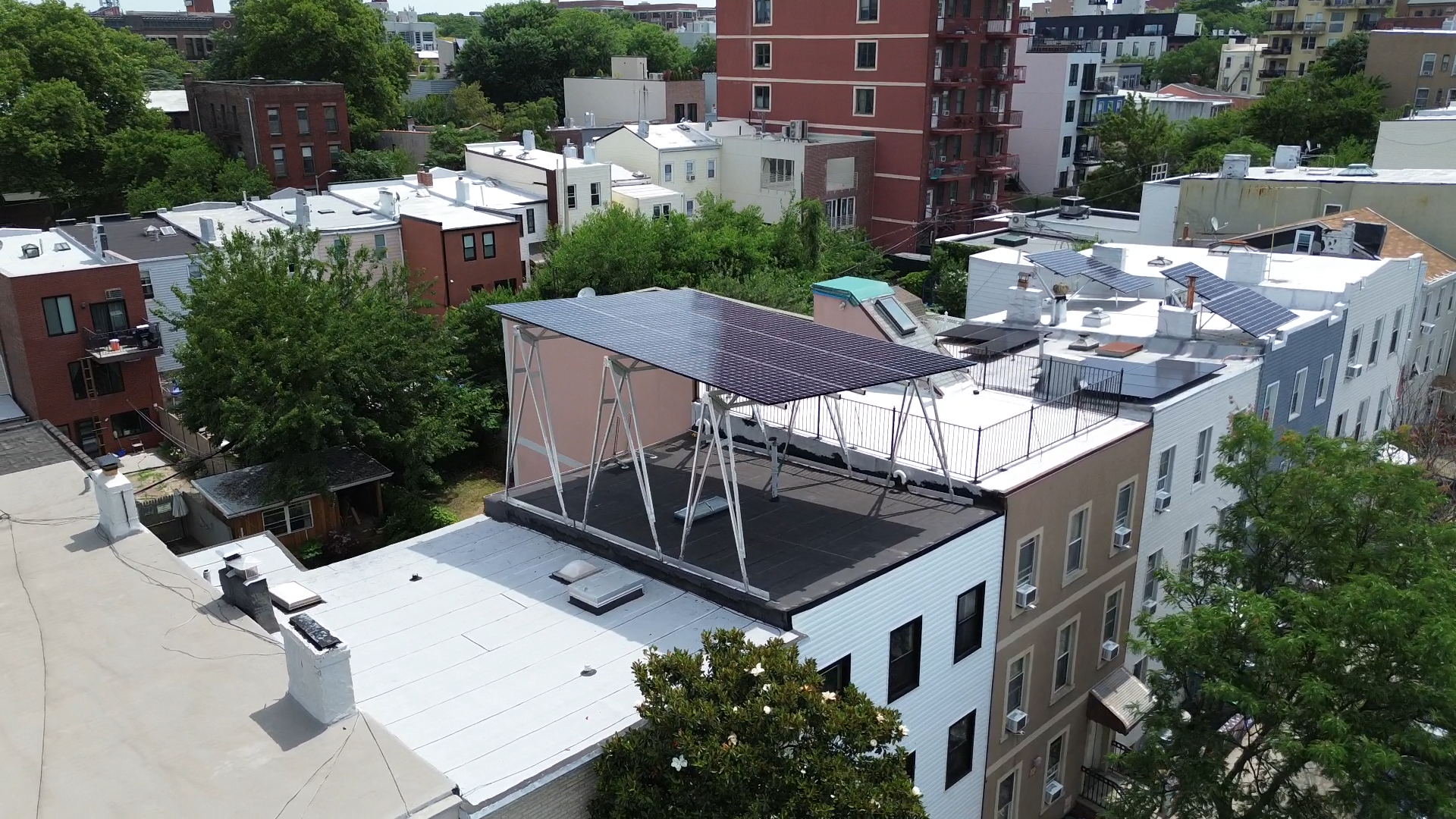Green Roof For a Park Slope Brownstone
How cool is this. A Park Slope couple decided last year that they wanted to build a green roof atop their brownstone and found, through the Brownstoner Forum, a local design firm called Prospect Architecture (which, in the spirit of full disclosure, also advertises on the Forum). The project, which combined a green roof, photovoltaic…


How cool is this. A Park Slope couple decided last year that they wanted to build a green roof atop their brownstone and found, through the Brownstoner Forum, a local design firm called Prospect Architecture (which, in the spirit of full disclosure, also advertises on the Forum). The project, which combined a green roof, photovoltaic array (solar power) and roof deck, is pretty unusual because of its small scale—most green roofs in the city to date (and there aren’t that many of them) have been on larger buildings. Here’s how the architects describe it:
Our design incorporates an intensive (which refers to the use of larger plants) green roof, a large Ipe wood (like teak) deck, a metal and Ipe roof over part of the deck, an aluminum clad bulkhead. A wall and trellis hide new a/c compressors. Solar panels will be installed on top of the roof over the deck, the bulkhead roof and in front of the a/c compressors and will provide roughly 50-60% of the clients power needs including the a/c system. Additionally, our design is experimenting with various shade tolerant plants, like ferns beneath the front solar array, which is expected to help cool the arrays and maintain their top efficiency as well as retain more moisture than the gravel alternative.
The design provokes a feeling of walking through a small meadow while at the same time reminding one of the city that is all around. It is a private oasis with distant vistas of Manhattan and the surrounding neighborhoods of Brooklyn. The planters and benches around the perimeter of the deck add greenery and carry one’s eye past the immediate rooftops to the more panoramic of views. On the south side of the garden, an aluminum-clad wall fashioned with vine covered trellises shield one from the sight and sound of the mechanicals. The specific placement and structure of the architectural elements not only maximize the use of the entire roof, but the modern design acts as a representation of the dichotomy between city and nature.
And what about the cost? A little over $200 a square foot, including demo, structural enhancement, new stairs and bulkhead. Lots more pics on the jump.
If you’ve done, or are in the midst of doing, a cool interior or exterior project like this that you’d like to share, please send us an email at brownstoner@brownstoner.com.









what kind of permits and/or variances would be needed to do something like this? is the bottomline that if it can’t be viewed from the street, you’re good, or is there more to it? also, any special hurdles if you’re in a historic landmark district?
“Indeed, the promise of solar, especially on this scale hasn’t delivered. It’s roughly 8% efficient. There are hundreds of other places to put your “green” dollars that will provide a better roi.”
That isn’t correct. The efficiency number you refer to is nothing to do with anything financial. If it wasn’t workable then why are their big investment firms paying for installs on top of grocery stores and other large buildings, in return for the rights to sell the electricity back to the building over 10 year time horizons?
Even if you don’t start profiting until 10 or 15 years out (assuming con-ed prices don’t grow faster than inflation) you DO get back your investment when selling the property. I think like other improvements such as kitchens, buyers are willing to pay as much or more than the original install cost for the right to take over your improvement.
Indeed, the promise of solar, especially on this scale hasn’t delivered. It’s roughly 8% efficient. There are hundreds of other places to put your “green” dollars that will provide a better roi.
GORGEOUS…Now that’s city living, a slice of heaven amid the chaos…ENJOY!
I bet at least 30% of that big price tag was for the solar panels.
The NY Times just did a story on green buildings. Solar Panels had a 15-year payback period. Way to long to make much sense for a homeowner (unless you want to make a big-$ green statement) until tech reduces the prices.
Here’s a great place to start looking for information regarding green roofs:
http://www.greenroofs.org/
If you have a commercial/industrial space that you want to build/renovate there is a great program in place through the state that includes incentives for construction costs and financing:
http://www.nyserda.org/default.asp
We are participating in the program and will include a 30,000 square foot roof garden as a part of a complete package of green systems for our facility.
Our experience is that both Bloomberg’s and Clinton Climate Initiative are all press release and no substance. The state has their act together though.
Berlin has been at the forefront of green roofs, Chicago is doing their best to catch up, and New York’s efforts are in it’s infancy.
Green roofs will make your roof last longer, reduce your heating and cooling needs, reduce stormwater runoff, and make for a much improved roof top picnic.
There are a ton of ways to do it cheaper than $200 per square foot. Having said that, they more than recouped their investment just in added value. Over thirty years this investment will pay for itself over and over and over…great job.
wow, that’s really gorgeous. of course i want to see the new stairwell & behind the HVAC wall too 🙂
As clarification, I didn’t mean you can’t buy ipe that is certified. But I’ve heard lots of anacdotal eveidence that those tropical plantations, while great for growing ipe trees, are hardly models of good environmental stewardship. I would love to hear otherwise.
Ipe is not sustainable, however it is class A rated for fire so you can put as much of it on you roof as you like. Basically it burns like steel. No self-respecting architect is likely to “ignore the rules” for something like this when their professional practice could be on the line (search this blog for Scarano). We used ipe on our roof but we chose 2×2 deck tiles which are supposedly are made of scrap (of course they may have been feeding us a line of (s)crap).
Extensive green roofs generally last much longer than traditional roof systems because the membrane is protected from UV and other damage by the growing substrate. Performing repairs may be slightly more complicated but you are certainly not fucked.
Generally, when doing a job like this you would take the roof down to the framing, removing everything else including the deck. If your framing is insufficient you can beef it up at that point and install a sufficient deck.